News
Garbage mountain: Danger signs before the tragedy
 Meethotamulla residents who lost their loved ones and homes in last week’s tragedy claim that for almost two months, there had been clear indications that the garbage mountain was about to collapse.
Meethotamulla residents who lost their loved ones and homes in last week’s tragedy claim that for almost two months, there had been clear indications that the garbage mountain was about to collapse.
Resident K. Sarathchandra said that two months ago, cracks started to appear beneath the garbage mountain. In some houses, walls also started to crack.
He said that in the tragedy, his daughter’s house was hit by rubble but the floor in the living rooms had shown signs of cracking. Some houses nearby also had water seeping through the cracks.
Mr Sarathchandra said that the night before the incident, dogs that were chained in the houses were howling and trying to run away. On the day of the incident, dogs were not seen in the area.
Keerthiratne Perera who lost four members of his family said that before the mountain of garbage tumbled down, he also noticed signs of danger in his house.
He said that in his daughter’s room a glass window had cracked hours before the disaster while the walls also slowly began to crack. The staircase behind the house even toppled on the three wheeler parked underneath.
Mr. Perera lost his wife, daughter, son-in-law and a granddaughter in the garbage landslide.
Ajith Abeywardena who was visiting his daughter’s house for the National New Year said he heard a loud noise when he was nearing the house.
When he reached the location, he saw that the top of the garbage dump was smoking with the lane and houses behind being covered by soil.
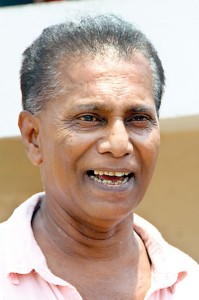
K. Sarathchandra
Mr. Abeywardena said while everyone at his daughter’s house escaped and the house was only damaged, they were told that they should move out as the house was in a high risk area.
On Friday, the Government provided 30 houses for those displaced due to the tragedy. Accordingly, one floor of the “Laksanda Sewana” building which belonged to the Urban Development Authority (UDA) was handed over to the families.
UDA Project Manager Ranjith Samarasinghe said the Colombo District Secretary had given them a list of 30 residents who were willing to accept houses from the Government. He said there were 68 more houses for those who were displaced.
Colombo District Secretary Sunil Kannangara said the houses could be provided even tomorrow if the displaced people were willing to move in. More houses could also be provided after July.
Mr Kannangara said many displaced people were reluctant to move into the new houses given by the Government. They had told officials that they preferred to obtain compensation for the damaged caused,
The District Secretary said the Government would also provide Rs 50,000 a month for three months to people who were ready to move into rented houses until they were given adequate compensation to rebuild their houses.
He said that affected people would be provided separate compensation in lieu of the Government taking over their land. They would be given another Rs. 250,000 to buy furniture and Rs 10,000 for transport.
“The Colombo Municipality has allocated Rs 300 million for the affected people while the Government would provide the rest of the money,” he said.
The district secretary said the people must leave the area if there was danger. “On the last occasion we removed people while providing them rent. But, some remained and demanded more money and they stayed until the mountain toppled on them,” he added.
As the focus now shifts to the resettling of displaced people and relocating those still living in the high risk zone, authorities are also grappling with how to dispose of the ever growing mini mountains of garbage that are starting to rise around Colombo.
According to the Megapolis and Western Development Ministry, upto 800 metric tonnes of garbage accumulate in Colombo on a daily basis.
Megapolis and Western Development Minister Patali Champika Ranawaka on Thursday told journalists that about one million square metres of garbage was currently lying at the Meethotamulla site. An area which had originally started out as a two acre plot of land to dump garbage from Kolonnawa in 2002 had later expanded to a 21 acre area that served as a dump for all of Colombo.
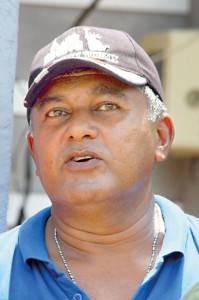
Ajith Abeywardane
With Meethotamulla no longer used as a dumping site, authorities have been trying throughout the past week to dump garbage accumulating in the city at different locations away from Colombo. Most of these attempts have been thwarted due to furious protests by area residents fearful of their own neighborhoods being turned into another Meethotamulla.
Municipal Commissioner V.K. Anura assured the public in comments to the Sunday Times last week that they would not allow garbage to pile up uncollected in the city. However, piles of garbage were clearly visible in many parts of Colombo this week due to difficulties in finding dumping sites.
In a bid to gain some measure of control, President Maithripala Sirisena on Thursday issued a gazette notification declaring garbage disposal as an ‘essential service.’ This means that protesters who obstruct garbage disposal efforts are liable to be arrested without a warrent by police.
The move, however, failed to prevent more anti-garbage dumping protests. Even on Friday, after the gazette notification was issued, protests broke out in several areas including Muthurajawela, Dompe and Ranala. At some places, garbage trucks only managed to get through after armed Special Task Force (STF) personnel and riot police forcibly evicted protesters blocking the access roads.
Police Spokesman Priyantha Jayakody said despite the powers granted to police under the new gazette, as of Friday evening, police had so far not arrested any protester for obstructing garbage disposal efforts.
While efforts to find a permanent solution to the garbage crisis are ongoing, the Government concedes that it would take at least two years for an effective garbage management system to be in place.
The Govt. said this week said there were three waste management plants for the Colombo region were being set up jointly with the private sector. But completion would take at least another two years. Therefore, the challenge is how to dispose of the garbage in this interim period.
One possible solution is the setting up of a central authority for solid waste management. President Maithripala Sirisena has already given orders for this.

A notice pasted on the door of a house in the danger zone, advising the families to move out. Pix by Indika Handuwala
| Solid Waste Management through Rapid CompostingThe Research Center for Social Sciences (RCSS) of the University of Kelaniya has presented a project proposal, which it claims can greatly reduce the accumulation of Municipal Solid Waste (MSW) in the country. The researchers claim that the proposed Rapid Composting Mechanism/Environmental Recycling System (ERS), which utilises Japanese technology, can solve the country’s organic garbage problem. Organic waste accounts for over 50% of waste generated in Sri Lanka. Jude Fernando, an external consultant for the project with the RCSS, told the Sunday Times that the project can prevent accumulation of organic garbage, which is the most challenging part of the MSW management in Sri Lanka. He said the project can convert garbage into fertilizer, livestock feed ingredients or even electricity. Rapid composting will be the first step of successful implementation of integrated MSW management in Sri Lanka, he added. He revealed that the researchers had been discussing this system with relevant authorities for the past one and a half years. |
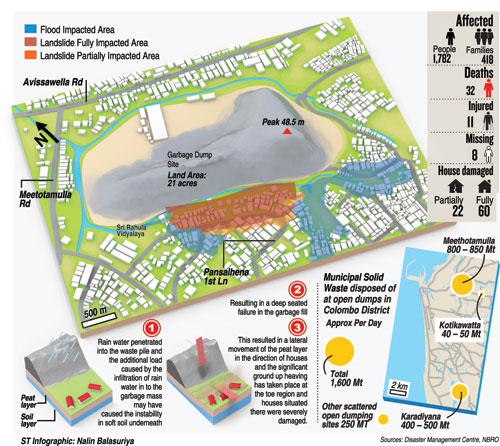
| Cause of the collapse: What experts and survivors say By Chrishanthi Christopher As geologists and structural experts grapple with the question of what caused Metthotamulla’s deadly garbage landslide on National New Year Day, survivors insist that it was a chemical sprayed by the Colombo municipality that triggered the tragedy in which more than 32 people perished. With experts still conducting investigations and poring over the data they have collected, an official report which was due on Friday has been further delayed. Although warnings were issued that the over 90 metre high garbage dump could collapse under its own weight, many residents said the disaster was precipitated by a chemical sprayed by Colombo Municipal authorities days before the tragedy. They said they saw a Fire Brigade bowser spraying a chemical on the surface of the heap. When they asked why it was being done, they were told it was to ward off the stench. Municipal Commissioner V.K. Anura confirmed that the CMC sprayed a chemical at the garbage dump to keep the smell off, but said it was not the first time they sprayed the chemical. “The spraying is done regularly,” he said. He refused to divulge the name of the deodorizer used, but said scientists had examined the chemical and found it to be harmless. Rejecting the residents’ claim that it was the chemical that caused the catastrophe, the commissioner said he believed that the garbage dump collapsed because of the heavy rain that the area experienced a few days before the tragedy. Colombo’s Fire Brigade Chief P.N.R. Fernando said a 6,000-litre capacity bowser was sent to the site along with two firemen and the driver, but they returned after two hours. Construction Ministry consultant C.H. Thalpe Gamage, who once served as the director of the Institute for Construction Training and Development (ICTAD), said a soil mountain could not remain stable beyond a height of 25 metres. The precariousness is more in the case of a garbage mountain as there is not enough cohesion and friction within. In addition, there is accumulation of bio-gas (methane) in pockets and even the heat produced by a slight friction can ignite a fire. Other experts said that when land fills reached a certain height, the surface should be covered with suitable cover material and gas collection wells should be installed on the capped landfill. Perforated pipes have to be inserted vertically to tap the gas being produced below and it can be used as a source of energy. Prof. Kapila Dahanayake, the Peradeniya University’s Sedimentologist, said he visited the Meethotamulla site and he believed local conditions at the site contributed to the collapse. The dump, he said, was situated on marshy land with a canal running by its side. “The foundation was shaky,” he said. According to him, increased moisture and the heat generated from within probably led to the garbage landslide. The hot temperature outside could also be an added contributor, he said. The geologist noted that the garbage dump had sloped upto the bank of the canal, allowing the water to seep through the garbage. Prof. Dahanayake said the authorities should carry out a thorough study of the area before they set up a garbage dump. Geologists and other experts should be consulted before dump yards were identified, he said. The emeritus professor said if decisions were taken based on proper geomorphic studies, people living near likely garbage sites need not fear of tragedies like Meethotamulla recurring. |
Flats for houses can never be the same 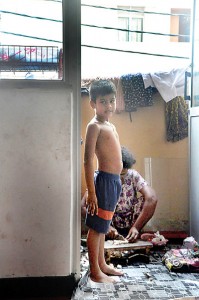 A family that has moved into a house provided by the Govt. Meethotamulla residents who accepted the Government’s offer of new houses expressed mixed feelings about their decision. Many said that, while they did not like to live in flats, they were compelled to accept them, as the disaster had deprived them of their own homes. Liyanage Niroshika said she was happy to receive a house from the Govt. She, however, stressed that, though she received a house and Rs.250,000 to buy furniture, it does not compensate for the two-story house she lost. “I am happy to be with the other 30 families who were our neighbours yet, life in a flat is a new experience. Therefore, it’s hard to believe that I would adjust to the new house. This house is all we have now. If the Govt, took this action earlier, many lives would have been saved,” she said. Another resident, Nilanthi Rajika, said she was happy with the Government’s quick response to provide houses “I was able to get house No.12 on the 9th floor. Though I accepted a house, many people are still refusing these houses saying, the quality of life is lesser in a flat. Some of the middle class people also don’t want to move into flats or displaced camps, due to their social status,” she said. Mihijaya Wibushitha said, though they received houses, he could not be satisfied due to the fact that, he would never get a house with a garden. He said that, earlier, his feet touched the soil and was able to, at least, plant a tree or keep pets, all of which has been lost after moving into the flat. |
“Psychological first aid” for Meethotamulla victims 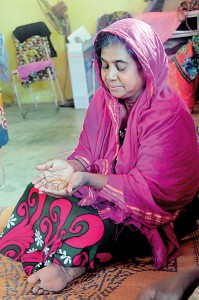 A survivor holds onto a few of her gold items after the tragedy. Pic by Amila Gamage The Meethotamulla disaster was a profoundly traumatic experience for hundreds of people. The psychological impact on victims is considerable. The first step of psychosocial support for them is “Psychological First Aid (PFA).” The tragedy saw the first coordinated implementation of PFA for the affected. The Health Ministry grouped counsellors from the Sri Lanka Navy, Army and the Dept of Social Services to provide PFA to the affected. The team is based at the Terrence N. De Silva Maha Vidyalaya in Meethotamulla, since the day the temporary welfare camp was established in the aftermath of the disaster. While helping the affected deal with psychosocial problems, the team has also been actively reaching out to those who had lost loved ones in the disaster, but had not come to or, register with authorities at the welfare camp set up at the college. The Counsellors said they had so far located 14 families who had lost family members in the disaster. All were not living at the camp, but were staying with friends or relatives. “They have suffered a devastating loss and, at a time like this, they aren’t really interested in coming to a camp or even obtaining aid,” one Counsellor observed. As such, the Counsellors had made it their mission to go to these people and offer them both psychological support, as well as material aid, which they needed, but had not come to collect, due to the emotional scars they continue to bear. Meanwhile, a separate programme is also being conducted by authorities to provide psychological support to children affected by the disaster. Officials from the National Child Protection Authority and Dept of Social Services are actively involved in this effort. They are assisted by teams of volunteers from youth organizations, such as the H3 Foundation. |

